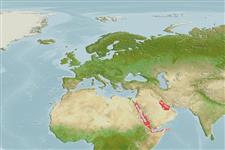Environment: milieu / climate zone / depth range / distribution range
Ekologi
laut; payau berasosiasi dengan karang; kisaran kedalaman 1 - 30 m (Ref. 89707). Tropical; 31°N - 9°N, 32°E - 55°E (Ref. 5222)
Western Indian Ocean: known only from the Red Sea and Gulf of Aden (Ref. 5222). Reported from Somalia and Socotra (Yemen).
Size / Weight / umur
Maturity: Lm ? range ? - ? cm
Max length : 52.0 cm TL jantan/; (Ref. 9710); common length : 40.0 cm TL jantan/; (Ref. 5450)
Duri punggung (Keseluruhan (total)): 11; duri punggung lunak (Keseluruhan (total)): 14-16; Duri dubur 3; Sirip dubur lunak: 8 - 9. Body robust. Serrae at the angle of the preopercle slightly enlarged; the upper edge of the operculum strongly convex. Posterior nostril of adults vertically elongate. Very similar to E. ongus which has longer pectoral fins, and a narrow white margin with broad blackish submarginal band on the median fins, which are absent or poorly developed in E. summana. Generally dark olive-brown to dark brownish gray with large pale blotches (most larger than the eye) and numerous small white spots overlying this pattern. Fins covered with small white spots, except for pectoral fins where the white spots are confined to the base.
Occurs in shallow protected coral reefs and in lagoons or brackish-water environments (Ref. 5222). No published information on the biology of this species has been found (Ref. 5222). Sold fresh in local markets (Ref. 5222).
Life cycle and mating behavior
Kematangan | Reproduksi, perkembang biakan | Pemijahan | telur-telur | Fecundity | Larva
Heemstra, P.C. and J.E. Randall, 1993. FAO Species Catalogue. Vol. 16. Groupers of the world (family Serranidae, subfamily Epinephelinae). An annotated and illustrated catalogue of the grouper, rockcod, hind, coral grouper and lyretail species known to date. Rome: FAO. FAO Fish. Synop. 125(16):382 p. (Ref. 5222)
Status IUCN Red List (Ref. 130435)
ancaman kepada manusia
Harmless
penggunaan manusia
Perikanan: nilai komersial kecil
informasi lanjut
Nama-nama umumSinonim (persamaan)metabolismePemangsaEkotoksikologiReproduksi, perkembang biakanKematanganPemijahanSpawning aggregationFecunditytelur-telurpekembangan telor
AcuanBudidaya airprofil budidaya airStrainGenetikaElectrophoresesDiturunkanPenyakit-penyakitPengolahanNutrientsMass conversion
mitraGambarStamps, Coins Misc.Suara-suaraCiguateraKecepatanTipe renangArea insangOtolithsOtakPenglihatan / visi
Alat, peralatan
laporan khas
muat turun XML
Sumber internet
Estimates based on models
Preferred temperature (Ref.
123201): 25.1 - 29.3, mean 28.6 °C (based on 150 cells).
Phylogenetic diversity index (Ref.
82804): PD
50 = 0.5000 [Uniqueness, from 0.5 = low to 2.0 = high].
Bayesian length-weight: a=0.01175 (0.00571 - 0.02419), b=3.04 (2.88 - 3.20), in cm total length, based on LWR estimates for this Genus-body shape (Ref.
93245).
Trophic level (Ref.
69278): 3.8 ±0.5 se; based on size and trophs of closest relatives
Daya lenting (Ref.
120179): sedang, Waktu penggandaan populasi minimum 1.4 - 4.4 tahun (Preliminary K or Fecundity.).
Fishing Vulnerability (Ref.
59153): Moderate vulnerability (41 of 100).
Climate Vulnerability (Ref.
125649): Very high vulnerability (83 of 100).
Nutrients (Ref.
124155): Calcium = 28.8 [12.7, 60.3] mg/100g; Iron = 0.473 [0.253, 0.981] mg/100g; Protein = 18.8 [17.2, 20.3] %; Omega3 = 0.124 [0.076, 0.198] g/100g; Selenium = 28.4 [16.3, 51.7] μg/100g; VitaminA = 183 [46, 765] μg/100g; Zinc = 1.55 [1.04, 2.18] mg/100g (wet weight);
